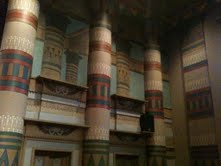The Middle-Aged Flavian Woman in an example of a Roman portrait. Roman portraits sought to balance a sense of idealism while taking a naturalistic approach. The woman depicted exemplifies this balance. The sculptor shows a high attention to anatomical detail and proportionality. According to Stokstad, even though the woman shown is remarkably realistic in her wrinkles and sagging skin, she still represents a hint of idealism. Her aged face and features show signs of an accomplished life and virtue. (190)
This statue of Constantine the Great was commissioned to be displayed in the Basilica Nova. It was used in place of the emperor himself whenever the law required his presence (212). The face is strong and muscular, displaying “no hint of human fragility or imperfection” (212).
The difference in the craftsmanship and attention to detail shown in each of these two pieces is stark. Even in the very beginning of the transition from Classical Roman to Early Byzantine art is plain to see. Although sculpted after the Flavian Woman, Constantine looks closer related to Archaic Greek Sculpture.










.jpg)




